Contributed by Quotient Travel Planner
For wildlife lovers, spotting even one animal in its natural habitat is an utterly memorable experience. But what’s even more scintillating is beholding a massive animal migration and literally being face-to-face with one of nature’s most inspiring wonders.
As the year turns and seasons change, manifold animals will begin an amazing journey, travelling vast distances — by hoof, wing or fin, and in herds, flocks or colonies — in search of a new habitat, a new environment, and more resources. Not only is this passage visually breathtaking, but it also plays a vital role in the world’s natural ecosystem.
If you’re in for some animal kingdom frenzy, here’s a look at five animal species that brave a compelling journey each year!
Also read: Go Crazy Over These 10 Absolutely Adorable Animal Islands
Wild Wild Beasts

Each year, wildebeests pursue a long-distance migration through Serengeti and Maasai Mara National Reserve.
If there were a World Cup of wildlife, surely the Great Migration would be its number one contender. Occurring throughout the year, wildebeests’ en masse movement literally revolves around the circle of life. The spectacle is extremely vivid: driven by an ancient rhythm, millions of wildebeests pound their hooves on the open plains, travelling north through Tanzania’s Serengeti and on to Kenya’s Maasai Mara National Reserve before returning south in early autumn. And what’s truly amazing is that nowhere in the world is there a more intense animal commotion: think a bonus of 500,000 zebras, 200,000 Thompson’s gazelles and 18,000 eland, which will exhibit the “herd behaviour” and join the roughly 1.5 million wildebeests!
Parting the red sea
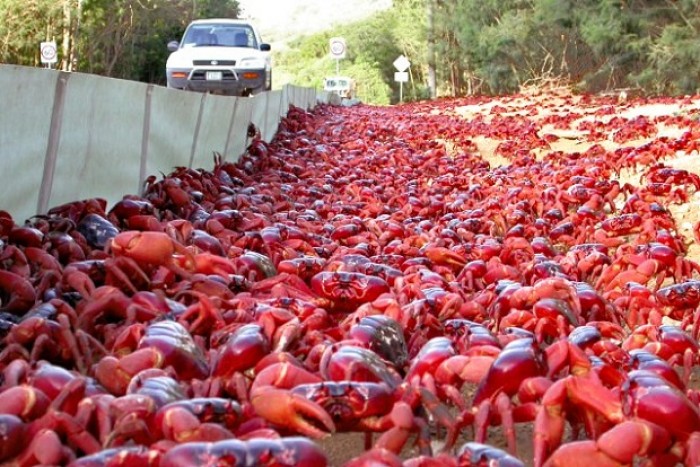 A total of 120 million of fiery-coloured crustaceans take over Christmas Island every year. | Image credit: Christmas Island Tourist Association/Max Orchard
A total of 120 million of fiery-coloured crustaceans take over Christmas Island every year. | Image credit: Christmas Island Tourist Association/Max Orchard
Native to the Christmas Island in Australia, the red crabs stay put in their dwelling most of the year until October or November, when the wet season returns and they begin their migration to the shore. The event coincides with the lunar cycle and the tide, and is a marvellous visual show, where about 120 million red crabs are the main characters of a grand performance. Taking over the beaches, swarming up the walls of the houses and clattering on top of the roofs, these ubiquitous crabs’ march is perhaps just a normal phenomenon in the eyes of locals, who even facilitate the smooth journey of these creepy-crawlies by installing “crab crossings” on the main roads and temporary signs at designated places. Well, to visitors, this is surely not a run-of-the-mill sighting, as each year, more travellers flock here to witness this unique natural wonder!
March of the Happy Feet
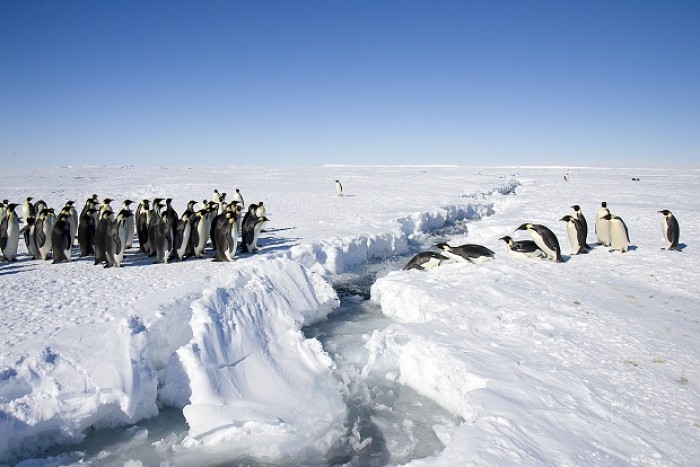 As Antarctica’s sea ice begins to thaw, emperor penguins begin their annual long trek. | Image credit: CC BY 2.0 (Christopher Michel, 2013)
As Antarctica’s sea ice begins to thaw, emperor penguins begin their annual long trek. | Image credit: CC BY 2.0 (Christopher Michel, 2013)
Portrayed so charmingly in Luc Jacquet’s documentary March of the Penguins, these comical little creatures boast an incredible determination to cross — donning an impeccable dinner-suit plumage and sauntering in a somewhat clumsy gait — the white continent in nippy temperatures, to mate and produce eggs. If you find yourself in Antarctica, expect to hear them before you see them, as their call for each other almost sounds like a welcoming song. But the very moment you spot them (sometimes huddling each other creating a perfect family portrait), you know you have come face-to-face with one of the planet’s most endearing species. As Antarctica’s sea ice begins to thaw, the majestic emperor penguins begin their annual bitingly long trek from the Antarctic coast to inland to hunt for food and lay their eggs — an event culminating in the hatching of thousands of chicks, which will have to brave the world exactly like their parents.
Pretty in pink
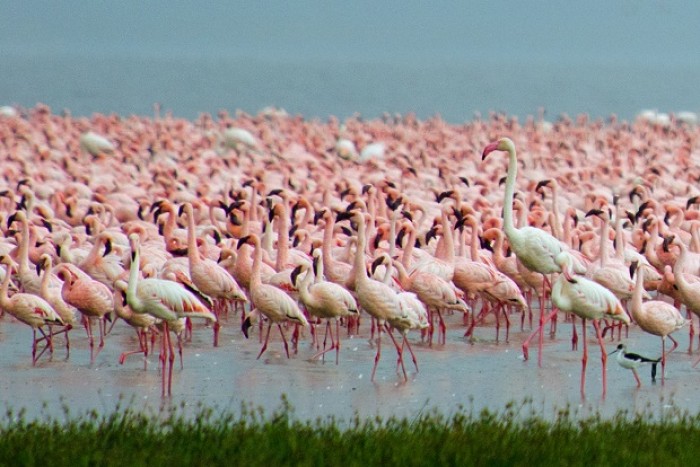 Image credit: CC BY-ND 2.0 (Brad, 2012)
Image credit: CC BY-ND 2.0 (Brad, 2012)
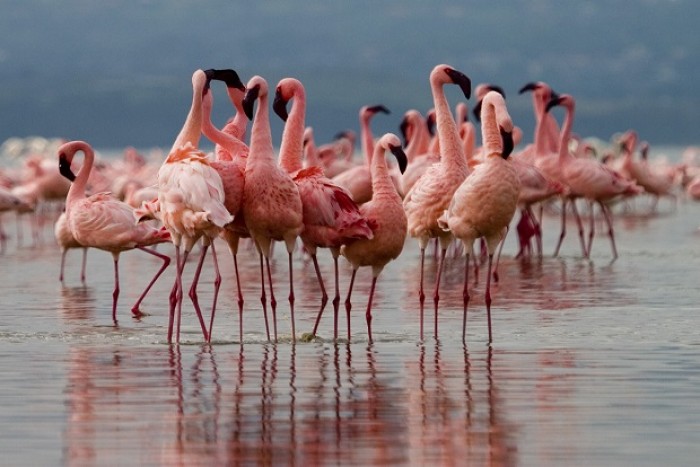 Each year, the Rift Valley Lakes welcomes thousands of lesser flamingos. | Image credit: CC BY-ND 2.0 (Uzi Yachin, 2005)
Each year, the Rift Valley Lakes welcomes thousands of lesser flamingos. | Image credit: CC BY-ND 2.0 (Uzi Yachin, 2005)
It is considered one of the most iconic birds on the planet for good reason: oddly shaped, atop crimson stilt legs with knees that bend backwards, and coloured in bright shades of rose, the lesser flamingo is one of nature’s real jewels. To get a glimpse of the spectacular flamingo, head to Kenya, from April to June, when these graceful birds flock to the Rift Valley Lakes such as Lake Nakuru and Lake Bogoria. There will be plenty of honking, splashing and flapping, but the image of thousands of coral-pink flamingos covering the shallow waters and feeding on algae is worth it and will give you the impression you’re part of a surreal movie.
Bou me over
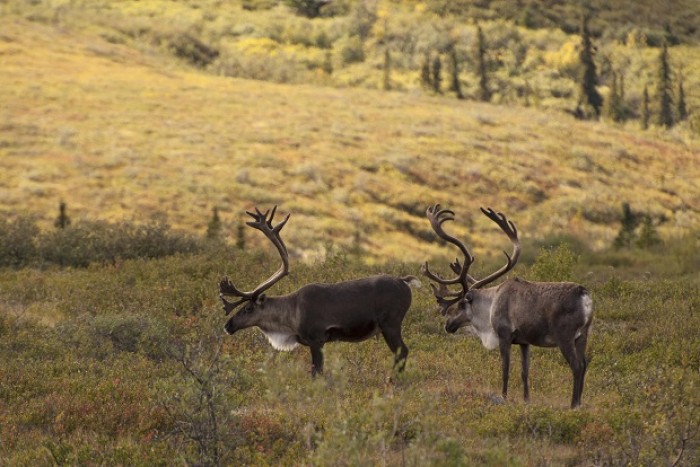 In summer, caribou herds head north in one of the world’s great large-animal migrations. | Image credit: CC BY 2.0 (Denali National Park and Preserve, 2013)
In summer, caribou herds head north in one of the world’s great large-animal migrations. | Image credit: CC BY 2.0 (Denali National Park and Preserve, 2013)
The mass-migration of North America’s caribou is a real feat of nature. As summer approaches, large nomadic herds will head north, dispersing throughout northeastern Alaska and the Yukon, travelling gruelling distances — crossing rivers, forests and plains — to end their journey in the abundant tundra, where they will feed on grasses and plants. It is a thrilling experience, really, to watch them climbing tundra ridges and swimming ice waters. Aim your binoculars to the valleys painted in crimson red and shimmering orange and observe as the landscape slowly swells to tens of thousands of animals!
Also read: 10 Exotic Animal Encounters Around the World
|
Witness being literally being face-to-face with one of nature’s most inspiring wonders at these destinations. You’d be happy to know that Quotient TravelPlanner specialises in bespoke travel, so that you can make that desired trip happen according to your preferences. Start building that epic holiday today, or choose from one of their many Ready To Tour packages. |





